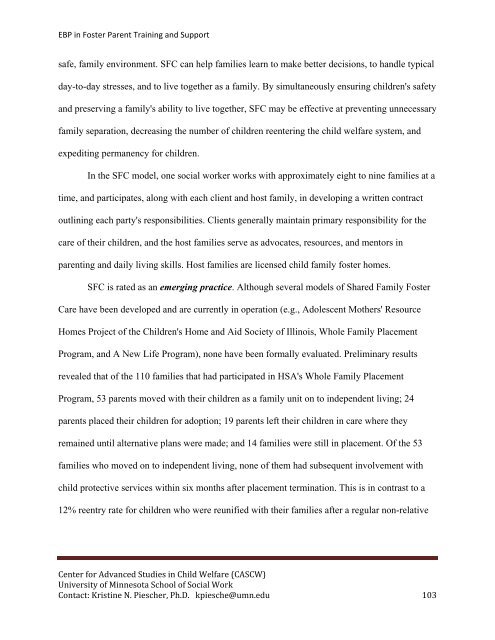Evidence-Based Practice in Foster Parent Training and Support ...
Evidence-Based Practice in Foster Parent Training and Support ...
Evidence-Based Practice in Foster Parent Training and Support ...
Create successful ePaper yourself
Turn your PDF publications into a flip-book with our unique Google optimized e-Paper software.
EBP <strong>in</strong> <strong>Foster</strong> <strong>Parent</strong> Tra<strong>in</strong><strong>in</strong>g <strong>and</strong> <strong>Support</strong>safe, family environment. SFC can help families learn to make better decisions, to h<strong>and</strong>le typicalday-to-day stresses, <strong>and</strong> to live together as a family. By simultaneously ensur<strong>in</strong>g children's safety<strong>and</strong> preserv<strong>in</strong>g a family's ability to live together, SFC may be effective at prevent<strong>in</strong>g unnecessaryfamily separation, decreas<strong>in</strong>g the number of children reenter<strong>in</strong>g the child welfare system, <strong>and</strong>expedit<strong>in</strong>g permanency for children.In the SFC model, one social worker works with approximately eight to n<strong>in</strong>e families at atime, <strong>and</strong> participates, along with each client <strong>and</strong> host family, <strong>in</strong> develop<strong>in</strong>g a written contractoutl<strong>in</strong><strong>in</strong>g each party's responsibilities. Clients generally ma<strong>in</strong>ta<strong>in</strong> primary responsibility for thecare of their children, <strong>and</strong> the host families serve as advocates, resources, <strong>and</strong> mentors <strong>in</strong>parent<strong>in</strong>g <strong>and</strong> daily liv<strong>in</strong>g skills. Host families are licensed child family foster homes.SFC is rated as an emerg<strong>in</strong>g practice. Although several models of Shared Family <strong>Foster</strong>Care have been developed <strong>and</strong> are currently <strong>in</strong> operation (e.g., Adolescent Mothers' ResourceHomes Project of the Children's Home <strong>and</strong> Aid Society of Ill<strong>in</strong>ois, Whole Family PlacementProgram, <strong>and</strong> A New Life Program), none have been formally evaluated. Prelim<strong>in</strong>ary resultsrevealed that of the 110 families that had participated <strong>in</strong> HSA's Whole Family PlacementProgram, 53 parents moved with their children as a family unit on to <strong>in</strong>dependent liv<strong>in</strong>g; 24parents placed their children for adoption; 19 parents left their children <strong>in</strong> care where theyrema<strong>in</strong>ed until alternative plans were made; <strong>and</strong> 14 families were still <strong>in</strong> placement. Of the 53families who moved on to <strong>in</strong>dependent liv<strong>in</strong>g, none of them had subsequent <strong>in</strong>volvement withchild protective services with<strong>in</strong> six months after placement term<strong>in</strong>ation. This is <strong>in</strong> contrast to a12% reentry rate for children who were reunified with their families after a regular non-relativeCenter for Advanced Studies <strong>in</strong> Child Welfare (CASCW)University of M<strong>in</strong>nesota School of Social WorkContact: Krist<strong>in</strong>e N. Piescher, Ph.D. kpiesche@umn.edu 103
















